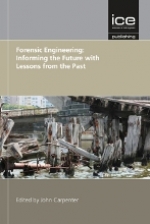Tab Article
Forensic Engineering: Informing the Future with Lessons from the Past is the published proceedings from the Institution of Civil Engineers’ Fifth International Conference on Forensic Engineering, held in London on 16-17 April 2013.
The conference maintained a 150 year tradition pioneered by Telford, Brunel and Stephenson, where lessons learned from failures lead to the development of improved design, construction and management practice.
Managing assets is particularly important in a difficult economic climate and so understanding where things have gone wrong in the past is vital. The papers in this book focus on the investigation of the fundamental causes of failure during the life of buildings, tunnels, bridges and foundations, which is crucial for optimising the construction and management of the built environment to deliver a better and more sustainable infrastructure.
Case studies include:
- 2009 Cumbrian floods
- The Japanese tsunami and lessons learned from the 2011 Tohoku earthquake
- The rebuilding of Woolwich Arsenal Clock Tower
- The collapse of the 1-35 W Mississippi River Bridge.
With more than 40 contributors, spread across 16 countries and six continents, this is an essential text, providing valuable lessons for owners, managers, developers and all those seeking to learn from the past to best manage their assets.


